A lot of girls can probably remember playing with Barbies at some point in their childhood. I had a couple myself, but most often, I chopped the hair off and went swimming with them and I’m pretty sure they all ended up in the trash at some point.
But the major memory that stuck out to me was playing with the little blonde dolls in the basement of one of my best friend’s house. It was the first time I really noticed anything in particular about the doll, mostly because I’d been too busy making a mess of it to pay attention to the original creation. I remember putting her in super short cocktail dress with insanely high heels and putting her in a car with her boyfriend Ken.
What I remember most though was when we took the dress off and I couldn’t help analyzing. Despite only being in the first grade, my friend was always so pretty. Despite the fact that she loved sweets, she never gained any weight. In terms of body proportions, she looked like Barbie.

Photo courtesy of amazon.com
There are some, including Mattel Executives, that may believe that Barbie never did psychological harm to young girls’ self-esteem, but I remember clearly looking down at myself, my not-so-little “bowling ball” belly as I came to refer to it and, for the first time, thinking I wasn’t a very pretty girl. For the first time, I saw my body as a bad thing.

Gif courtesy of giphy.com
I don’t think I’m the only one who has had an experience like that, considering that Barbie sales have been dropping steadily for three years now. Maybe that’s what finally convinced Mattel to change Barbie’s image for the better.
Mattel released a new line of Barbies on January 26. Among the dolls, the “Original Barbie” was still available, in all her blonde hair and super-thin glory, but three new types were also released. “Curvy Barbie,” “Tall Barbie,” and “Petite Barbie” are now being offered.
But they are not friends or sidekicks to the Original, each and every one is their own Barbie. The announcement came via a video presentation entitled “The Evolution of Barbie” featuring young girls playing with the new Barbies, talking about seeing ones that look like themselves, their friends, and their moms.

Photo courtesy of mattel.com
Not only did the body types change, but Mattel claims that each Barbie comes in seven skin tones, 24 hairstyle, and 22 eye colors.
Although it was most likely done in an attempt to raise sales, the reason matters a lot less than the result. The question of whether or not Barbie really does have an effect on girls’ self esteem was tested in a survey done in 2005 which exposed girls to Barbie in different scenarios, like trying on clothes or getting ready to go to a party.
After these scenes played out, girls ages 5 and a half to 7 and a half were questioned on their own body beliefs which led to the finding that these girls, particularly the older ones in the group, were dissatisfied with their bodies and wanted a thinner body like Barbie. Body dissatisfaction at a young age like that can lead to more serious issues in the future, like eating disorders.
The years when children play with Barbies are during the formative years. If a little girl sees herself in her favorite doll, who gets to go out and have tons of friends, maybe she’ll think she deserves all those things too. It would be naive to think that a Barbie doll could change all of young girls’ body image issues, but it is a step in the right direction.


